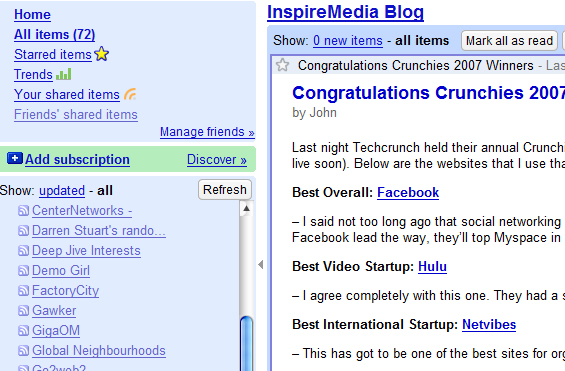RSS Feeds and Readers… A Primer For Bloggers and Blog Readers Alike
For many of my clients, this post may seem a little too simple. More and more, I get questions on the basics of RSS feeds and how they are used to benefit blogs and news sites and the general blog reader. My goal with this post is to help answer some of those questions and to help proliferate the use of RSS feeds.
RSS Feeds. I love them. They organize my popular websites, improve my productivity, give me only the information that I want to see and help spread the content from my blog further.
So, what is RSS? In short, it’s called Really Simple Syndication (or Rich Site Summary or Atom depending on who you get your information from). RSS is a way to syndicate content from your website, blog, etc and make it available for others to access using an RSS reader. Most blogs (in fact almost all, including mine) come with an RSS feed with it that helps to syndicate the content you make on your blog for readers.
For example, say I went to a website like Techcrunch.com and I don’t want to have to go back to their website everytime I want to view their content, so I access their RSS feed and give that web address to my RSS feed reader (in my case, I use Google Reader). This funnels all of my news sources and blogs into one source so that I can get all of my updates quickly without having to visit every single website.
In addition, RSS feeds help me to distribute my content faster and better. You see, when I make a post to my blog, it automatically updates the RSS feed that my readers subscribe to, allowing them almostinstantaneous access to the content I posted.
A common misconception with RSS Feeds
There is also a little bit of confusion with RSS feeds, particularly when readers first look at a feed, often times all they see is code. For example, look at the sample below from my own RSS feed:
<?xml version="1.0" encoding="UTF-8"?> <?xml-stylesheet href="http://feeds.feedburner.com/~d/styles/rss2full.xsl" type="text/xsl" media="screen"?><?xml-stylesheet href="http://feeds.feedburner.com/~d/styles/itemcontent.css" type="text/css" media="screen"?><!-- generator="wordpress/2.1" --><rss xmlns:content="http://purl.org/rss/1.0/modules/content/" xmlns:wfw="http://wellformedweb.org/CommentAPI/" xmlns:dc="http://purl.org/dc/elements/1.1/" version="2.0"> <channel> <title>InspireMedia Blog</title> <link>https://inspiremediacode.com</link> <description>The mind of John Wooton</description> <pubDate>Sun, 20 Jan 2008 05:13:21 +0000</pubDate> <generator>http://wordpress.org/?v=2.1</generator>
<language>en</language> <atom10:link xmlns:atom10="http://www.w3.org/2005/Atom" rel="self" href="http://feeds.feedburner.com/InspiremediaBlog" type="application/rss+xml" /><item> <title>Tetris Revamped</title> <link>https://inspiremediacode.com/2008/01/19/tetris-revamped/</link> <comments>https://inspiremediacode.com/2008/01/19/tetris-revamped/#comments</comments> <pubDate>Sat, 19 Jan 2008 21:34:29 +0000</pubDate>
<dc:creator>John</dc:creator> <category><![CDATA[Links]]></category> <category><![CDATA[Websites]]></category> <guid isPermaLink="false">https://inspiremediacode.com/2008/01/19/tetris-revamped/</guid> <description><

TEACH ME!!!!